Event Start
Event End
Location
Abstract
Satellite communication (SatCom) is an essential component of next-generation wireless communications. The existing terrestrial network will be overwhelmed due to the rapid growth of demand for data and serving remote areas by using only terrestrial networks is demanding. In addition, terrestrial communications are susceptible to natural disasters such as earthquakes and floods. In order to overcome these disadvantages of the terrestrial communication systems, SatCom systems are being deployed and covering remote or sparsely populated areas. However, research on SatCom is still not enough and it has not been studied as much as on terrestrial communication.
In this thesis, we investigate and analyze system models using SatCom. Furthermore, we present to improve the performance of SatCom by applying the proposed techniques in terrestrial communications.
First of all, we analyze the outage probability and symbol error rate of the SatCom system. In single-beam and multi-beam situations, all factors that can be considered in the SatCom channel model are considered. Since the beam coverage of the satellite is broad, a number of users are randomly distributed within the beam. We investigate the performance of the SatCom system according to the user selection methods considering the user's location as well.
Secondly, a system in which multiple gateways transmit signals over multiple beams is taken into account. Many users are placed in each beam, and inter-beam interference exists due to full-frequency reuse. To simultaneously cover the multiple users in the beam, signals are transmitted using non-orthogonal multiple access. In order to maximize system throughput, precoding for interference mitigation and NOMA optimization techniques are proposed.
Finally, a cognitive radio network in which high-altitude platforms (HAPs) are applied to conventional SatCom systems and share frequency bands with SatCom is taken into consideration. HAPs are used to cover user-dense areas within satellite beam coverage. In order to properly handle interference caused by spectrum sharing and improve the system data rate, precoding and frequency band allocation schemes are proposed.
Brief Biography
Dong Hyoun Na received the B.S. degree in electrical engineering from Korea University, Seoul, South Korea, in 2017, respectively, where he is currently pursuing the Ph.D. degree with the School of Electrical Engineering. He is also pursuing the Ph.D. degree with the Division of Computer, Electrical, Mathematical Science and Engineering (CEMSE), King Abdullah University of Science and Technology (KAUST), Thuwal, Saudi Arabia. His current research interest includes performance analysis and optimization of satellite communication systems.


